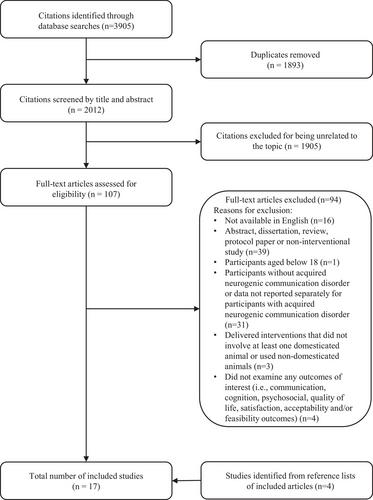Animal-assisted services for adults with acquired neurogenic communication disorders: A scoping review
Abstract
Background
There is increasing interest in the incorporation of animal-assisted services (AAS) in therapy for adults with acquired neurogenic communication disorders. AAS have the potential to enhance speech and language therapy engagement and outcomes. However, a greater understanding of the nature and potential benefits of these interventions is needed.
Aims
To describe the existing evidence for the incorporation of AAS in therapy with adults with acquired neurogenic communication disorders and to identify areas for future research.
Methods & Procedures
A scoping review was conducted and reported in alignment with the Preferred Reporting Items for Systematic Reviews and Meta-analyses checklist extension for scoping reviews (PRISMA-ScR). Seven databases (PubMed, Embase, CINAHL, PsycINFO, Cochrane, Scopus, Web of Science) and grey literature (Google) were searched. Two reviewers independently screened titles, abstracts and full texts against eligibility criteria using Covidence software. The Template for Intervention Description and Replication (TIDieR) checklist guided extraction of intervention data.
Main Contributions
A total of 17 studies with adults with aphasia, apraxia of speech and cognitive–communication disorders were included. While terminology varied, most interventions met the definition of animal-assisted therapy or animal-assisted activity and used therapy dogs. Across studies, a range of outcomes were targeted, and positive benefits were reported for participant mood, emotions, motivation and satisfaction. There were mixed, but mostly positive, benefits on social behaviour, communication and participation.
Conclusions & Implications:
AAS has been incorporated in therapy for adults with acquired neurogenic communication disorders, predominately with people with dementia. Across studies, communication impairments and AAS interventions were insufficiently or inconsistently described. Improved reporting would assist understanding of the potential benefits of AAS as an adjunct therapy. A quality appraisal of existing studies, and meta-analysis of findings, is needed to draw conclusions about the effectiveness of AAS as a complementary therapy for people with acquired neurogenic communication disorders.
WHAT THIS PAPER ADDS
What is already known on this subject
- There is increasing interest and research in AAS as an adjunct to traditional speech and language therapy. Several clinical populations have been shown to benefit from the incorporation of AAS as a complementary therapy approach, including adults with acquired neurogenic communication disorders. To date there has not been a comprehensive review of literature in the area.
What this paper adds to the existing knowledge
- This review aimed to describe what is known about AAS as an adjunct intervention for adults with acquired neurogenic communication disorders. A total of 17 studies were identified, the majority conducted with people living with dementia. Overall, consistent positive benefits of AAS were reported on participant mood, positive emotions, motivation, and satisfaction. There were mixed, but mostly positive, benefits of AAS on social behaviour, including both verbal and non-verbal communication outcomes, and participation.
What are the practical and clinical implications of this work?
- These results suggest a potential therapeutic benefit for the inclusion of AAS into traditional modalities used by speech–language therapists with people with acquired neurogenic communication disorders. However, clinicians should view these findings with caution. Studies were often insufficiently or inconsistently reported, and a quality appraisal and meta-analysis of existing studies would be needed to draw clear conclusions on the effectiveness of AAS as a complementary approach for people with acquired neurogenic communication disorders.


 求助内容:
求助内容: 应助结果提醒方式:
应助结果提醒方式:


